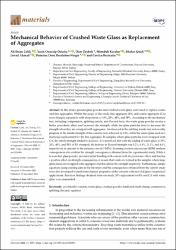| dc.contributor.author | Çelik, Ali İhsan | |
| dc.contributor.author | Özkılıç, Yasin Onuralp | |
| dc.contributor.author | Zeybek, Özer | |
| dc.contributor.author | Karalar, Memeduh | |
| dc.contributor.author | Qaidi, Shaker | |
| dc.contributor.author | Ahmad, Jawad | |
| dc.date.accessioned | 2022-11-29T06:55:15Z | |
| dc.date.available | 2022-11-29T06:55:15Z | |
| dc.date.issued | 2022 | en_US |
| dc.identifier.citation | Çelik, A. ̇I.; Özkılıç, Y.O.;Zeybek, Ö.; Karalar, M.; Qaidi, S.; Ahmad, J.; Burduhos-Nergis, D.D.; Bejinariu, C. Mechanical Behavior of Crushed Waste Glass as Replacement of Aggregates. Materials 2022, 15,8093. https://doi.org/10.3390/ma15228093 | en_US |
| dc.identifier.issn | 1996-1944 | |
| dc.identifier.uri | https://doi.org/10.3390/ma15228093 | |
| dc.identifier.uri | https://hdl.handle.net/20.500.12809/10409 | |
| dc.description.abstract | In this study, ground glass powder and crushed waste glass were used to replace coarse and fine aggregates. Within the scope of the study, fine aggregate (FA) and coarse aggregate (CA) were changed separately with proportions of 10%, 20%, 40%, and 50%. According to the mechanical test, including compression, splitting tensile, and flexural tests, the waste glass powder creates a better pozzolanic effect and increases the strength, while the glass particles tend to decrease the strength when they are swapped with aggregates. As observed in the splitting tensile test, noteworthy progress in the tensile strength of the concrete was achieved by 14%, while the waste glass used as a fractional replacement for the fine aggregate. In samples where glass particles were swapped with CA, the tensile strength tended to decrease. It was noticed that with the adding of waste glass at 10%, 20%, 40%, and 50% of FA swapped, the increase in flexural strength was 3.2%, 6.3%, 11.1%, and 4.8%, respectively, in amount to the reference one (6.3 MPa). Scanning electron microscope (SEM) analysis consequences also confirm the strength consequences obtained from the experimental study. While it is seen that glass powder provides better bonding with cement with its pozzolanic effect and this has a positive effect on strength consequences, it is seen that voids are formed in the samples where large glass pieces are swapped with aggregate and this affects the strength negatively. Furthermore, simple equations using existing data in the literature and the consequences obtained from the current study were also developed to predict mechanical properties of the concrete with recycled glass for practical applications. Based on findings obtained from our study, 20% replacement for FA and CA with waste glass is recommended. | en_US |
| dc.item-language.iso | eng | en_US |
| dc.publisher | MDPI | en_US |
| dc.relation.isversionof | 10.3390/ma15228093 | en_US |
| dc.item-rights | info:eu-repo/semantics/openAccess | en_US |
| dc.subject | Eco-friendly concrete | en_US |
| dc.subject | Waste glass | en_US |
| dc.subject | Crushed | en_US |
| dc.subject | Powder | en_US |
| dc.subject | Hardened | en_US |
| dc.subject | Fresh | en_US |
| dc.subject | Slump | en_US |
| dc.subject | Compressive | en_US |
| dc.subject | Splitting | en_US |
| dc.subject | Flexural | en_US |
| dc.subject | Equation | en_US |
| dc.title | Mechanical Behavior of Crushed Waste Glass as Replacement of Aggregates | en_US |
| dc.item-type | article | en_US |
| dc.contributor.department | MÜ, Mühendislik Fakültesi, İnşaat Mühendisliği Bölümü | en_US |
| dc.contributor.institutionauthor | Zeybek, Özer | |
| dc.identifier.volume | 15 | en_US |
| dc.identifier.issue | 22 | en_US |
| dc.relation.journal | Materials | en_US |
| dc.relation.publicationcategory | Makale - Uluslararası Hakemli Dergi - Kurum Öğretim Elemanı | en_US |


















